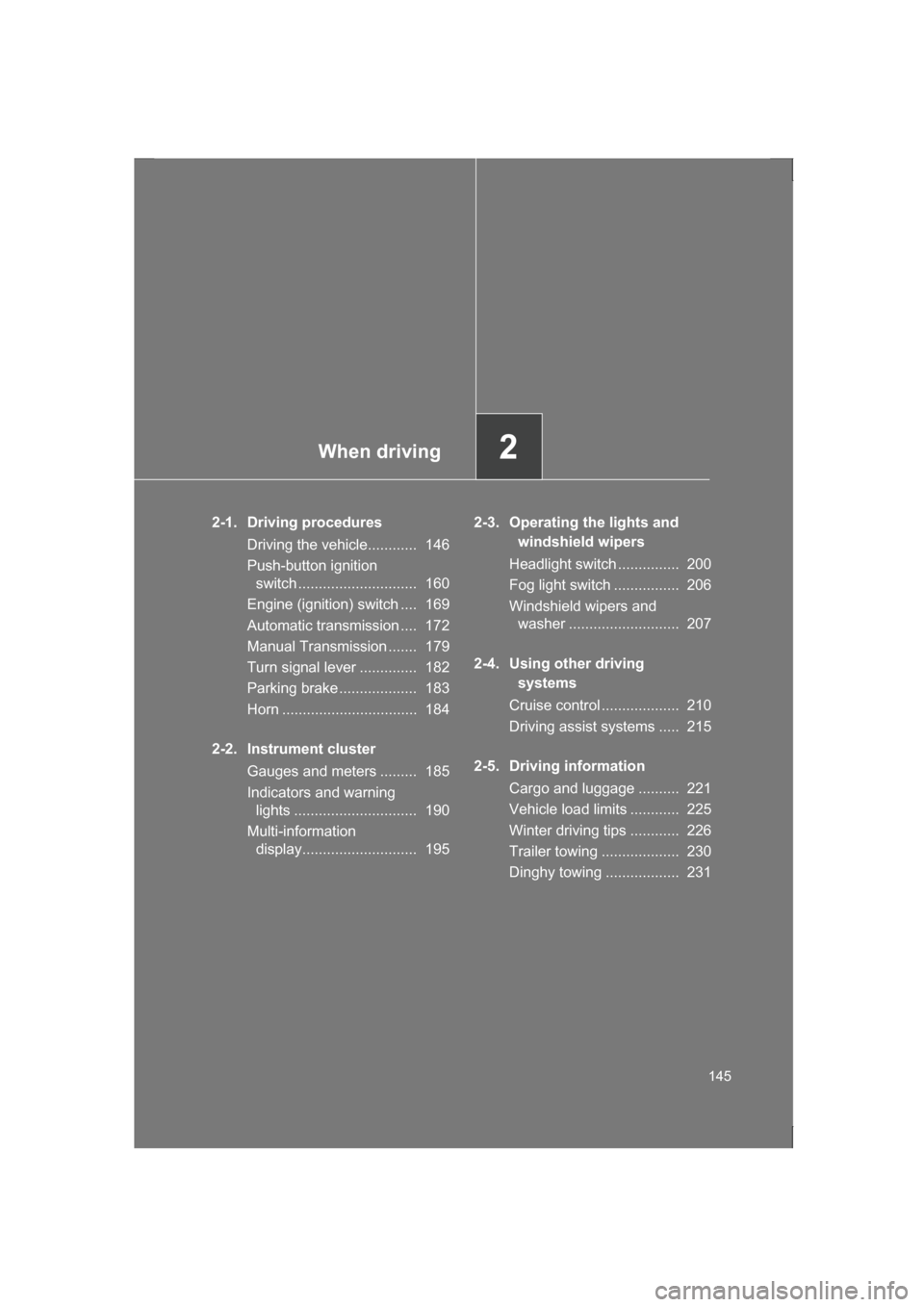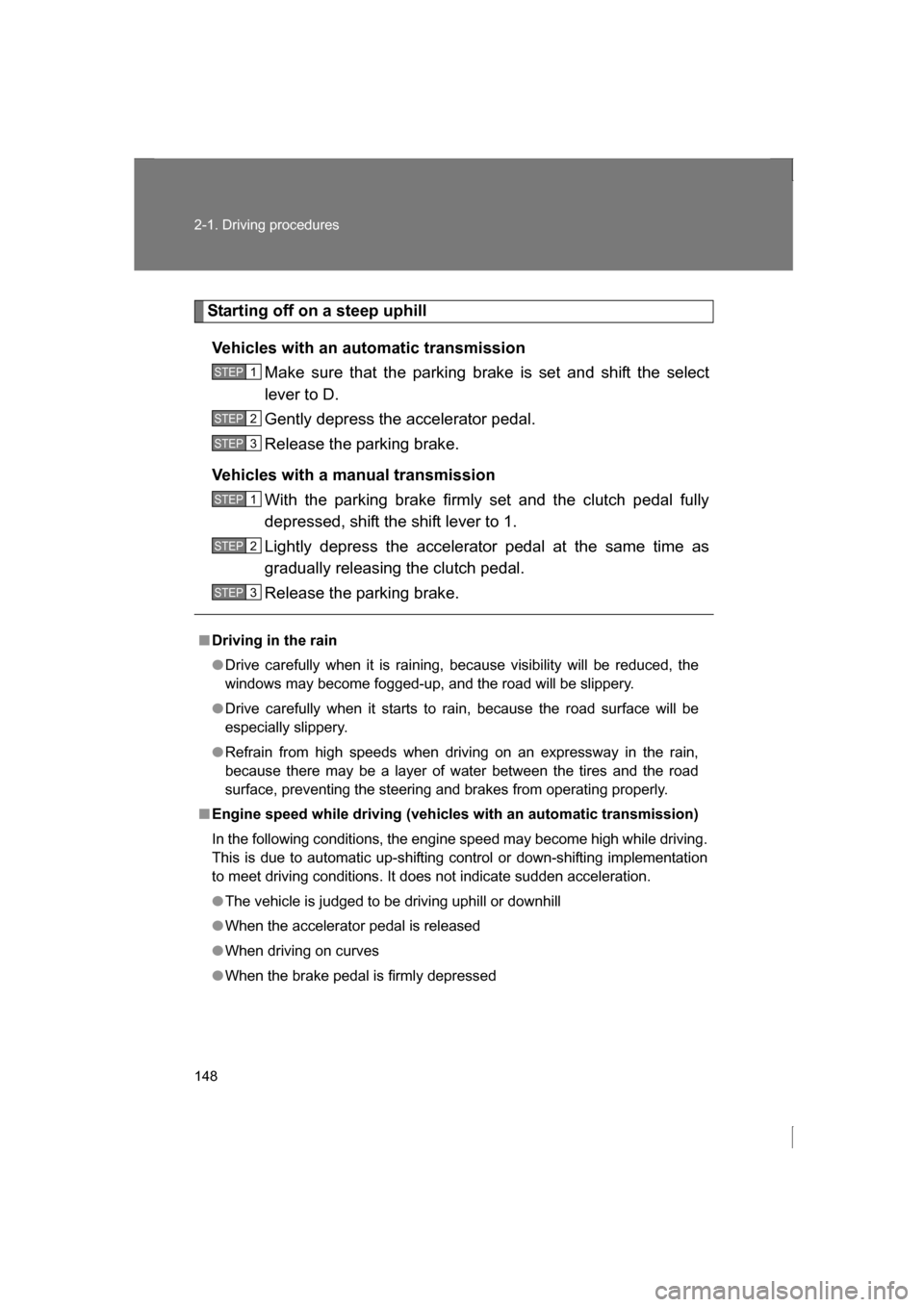Page 2 of 484

TABLE OF CONTENTSIndex
2
1-1. Key information
Keys ..................................... 20
1-2. Opening, closing and locking the doors and
trunk lid
Keyless access with push button start system ............. 23
Remote keyless entry system ................................ 37
Doors.................................... 42
Trunk lid ............................... 45
1-3. Adjustable components (seats, mirrors,
steering wheel)
Front seats ........................... 51
Rear seats ............................ 54
Head restraints ..................... 56
Seatbelts .............................. 58
Steering wheel ..................... 65
Anti-glare inside rear view mirror.......................... 66
Outside rear view mirrors ..... 67
1-4. Opening and closing the windows
Power windows .................... 70
1-5. Refueling Opening the fuel tank cap .... 73 1-6. Security system
Engine immobilizer system ................................ 77
Theft prevention labels (U.S.A.) ............................... 80
Alarm .................................... 81
1-7. Safety information Correct driving posture ......... 85
SRS airbag (Supplemental Restraint System airbag) .... 87
Front passenger occupant detection system .............. 122
Child restraint systems ....... 132
Installing child restraints ..... 136
2-1. Driving procedures Driving the vehicle .............. 146
Push-button ignition switch ............................... 160
Engine (ignition) switch....... 169
Automatic transmission ...... 172
Manual Transmission ......... 179
Turn signal lever ................. 182
Parking brake ..................... 183
Horn .................................... 184
1Before driving
2When driving
Page 10 of 484
10∗
: If equipped
C
Pictorial indexInterior
Select lever ∗
Shift lever ∗ P. 172
P. 179
Parking brake lever P. 183
Vehicle stability control (VSC)/TRAC off switch P. 216, 218
Seat heater switches ∗ P. 266
“VSC SPORT” switch P. 217
Power outlet P. 264
Shift lock release button ∗ P. 392
Driving pattern selector switch ∗ P. 174
Page 15 of 484
15
Installation of a mobile two-way radio systemThe installation of a mobile two-way radio system in your vehicle could affect
electronic systems such as: ● Multiport fuel injection system/sequential multiport fuel injection system
● Cruise control system
● Anti-lock brake system
● SRS airbag system
● Seatbelt pretensioner system
Be sure to check with your SUBARU dealer for precautionary measures or
special instructions regarding installation of a mobile two-way radio system.
Page 55 of 484

55
1-3. Adjustable components (seats, mirrors, steering wheel)
1
Before driving
WARNING
■When folding the rear seatbacks down
Observe the following precautions. Failure to do so may result in death or
serious injury.
●Do not fold the seatbacks down while driving.
●Stop the vehicle on level ground, set the parking brake and shift the select
lever to P (automatic transmission) or shift lever to neutral (manual trans-
mission).
●Do not allow anyone to sit on a folded seatback or in the trunk while driv- ing.
●Do not allow children to enter the trunk.
■After returning the rear seatback to the upright position
Observe the following precautions. Failure to do so may result in death or
serious injury.
●Check that the seatbelts are not twisted or caught in the seatback.
■Before using the rear seatbelts
●Make sure that the seatback is securely
locked in position by lightly pushing it
back and forth.
If the seatback is not securely locked,
the red portion of the seatback lock
release button will be visible. Make
sure that the red portion is not visible.
●Always make sure that the seatbelt is
not caught in the seatback or twisted in
one of the hooks that secure the seat-
back. Failure to do so may cause the
seatbelt to not be fastened correctly or
to become ineffective in a collision,
resulting in serious injury.
Page 145 of 484

When driving2
145
2-1. Driving proceduresDriving the vehicle............ 146
Push-button ignition switch ............................. 160
Engine (ignition) switch .... 169
Automatic transmission .... 172
Manual Transmission ....... 179
Turn signal lever .............. 182
Parking brake ................... 183
Horn ................................. 184
2-2. Instrument cluster Gauges and meters ......... 185
Indicators and warning lights .............................. 190
Multi-information display............................ 195 2-3. Operating the lights and
windshield wipers
Headlight switch ............... 200
Fog light switch ................ 206
Windshield wipers and washer ........................... 207
2-4. Using other driving systems
Cruise control ................... 210
Driving assist systems ..... 215
2-5. Driving information Cargo and luggage .......... 221
Vehicle load limits ............ 225
Winter driving tips ............ 226
Trailer towing ................... 230
Dinghy towing .................. 231
Page 146 of 484

146
2-1. Driving procedures
Driving the vehicle
The following procedures should be observed to ensure safe driv-
ing:
■Starting the engine
→P. 160, 169
■Driving
Vehicles with an automatic transmission With the brake pedal depressed, shift the select lever to D. (→ P. 172)
Release the parking brake. ( →P. 183)
Gradually release the brake pedal and gently depress the
accelerator pedal to accelerate the vehicle.
Vehicles with a manual transmission While depressing the clutch pedal, shift the shift lever to 1. (→ P. 179)
Release the parking brake. ( →P. 183)
Gradually release the clutch pedal. At the same time, gently
depress the accelerator pedal to accelerate the vehicle.
■Stopping
Vehicles with an automatic transmission With the select lever in D, depress the brake pedal.
If necessary, set the parking brake.
If the vehicle is to be stopped for an extended period of time, shift
the select lever to P or N. ( →P. 172)
Vehicles with a manual transmission While depressing the clutch pedal, depress the brake
pedal.
If necessary, set the parking brake.
If the vehicle is to be stopped for an extended period of time, shift
the shift lever to neutral. ( →P. 179)
STEP 1
STEP 2
STEP 3
STEP 1
STEP 2
STEP 3
STEP 1
STEP 2
STEP 1
STEP 2
Page 147 of 484

147
2-1. Driving procedures
2
When driving
■Parking the vehicle
Vehicles with an automatic transmission With the select lever in D, depress the brake pedal.
Shift the select lever to P. ( →P. 172)
Set the parking brake. ( →P. 183)
Vehicles without a keyless access with push button start
system:
Turn the engine switch to the “LOCK” position to stop the
engine.
Vehicles with a keyless access with push button start sys-
tem:
Press the push-button ignition switch to stop the engine.
Lock the door, making sure that you have the key on your
person.
If parking on a hill, block the wheels as needed.
Vehicles with a manual transmission While depressing the clutch pedal, depress the brake
pedal.
Shift the shift lever to neutral. ( →P. 179)
Set the parking brake. ( →P. 183)
Vehicles without a keyless access with push button start
system:
Turn the engine switch to the “LOCK” position to stop the
engine.
Vehicles with a keyless access with push button start sys-
tem:
Press the push-button ignition switch to stop the engine.
Lock the door, making sure that you have the key on your
person.
If parking on a hill, shift the shift lever to 1 or R and block the
wheels as needed.
STEP 1
STEP 2
STEP 3
STEP 4
STEP 5
STEP 1
STEP 2
STEP 3
STEP 4
STEP 5
Page 148 of 484

148
2-1. Driving procedures
Starting off on a steep uphillVehicles with an automatic transmission Make sure that the parking brake is set and shift the select
lever to D.
Gently depress the accelerator pedal.
Release the parking brake.
Vehicles with a manual transmission With the parking brake firmly set and the clutch pedal fully
depressed, shift the shift lever to 1.
Lightly depress the accelerator pedal at the same time as
gradually releasing the clutch pedal.
Release the parking brake.
■Driving in the rain
●Drive carefully when it is raining, because visibility will be reduced, the
windows may become fogged-up, and the road will be slippery.
●Drive carefully when it starts to rain, because the road surface will be
especially slippery.
●Refrain from high speeds when driving on an expressway in the rain,
because there may be a layer of water between the tires and the road
surface, preventing the steering and brakes from operating properly.
■Engine speed while driving (vehicl es with an automatic transmission)
In the following conditions, the engine speed may become high while driving.
This is due to automatic up-shifting c ontrol or down-shifting implementation
to meet driving conditions. It does not indicate sudden acceleration.
●The vehicle is judged to be driving uphill or downhill
●When the accelerator pedal is released
●When driving on curves
●When the brake pedal is firmly depressed
STEP 1
STEP 2
STEP 3
STEP 1
STEP 2
STEP 3